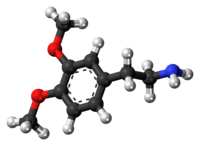3,4-Dimethoxyphenethylamine
 | |
 | |
| Names | |
|---|---|
| IUPAC name
2-(3,4-dimethoxyphenyl)ethylamine | |
| Identifiers | |
| 120-20-7 | |
| 3D model (Jmol) | Interactive image |
| ChEBI | CHEBI:136995 |
| ChEMBL | ChEMBL26019 |
| ChemSpider | 8114 |
| ECHA InfoCard | 100.003.979 |
| PubChem | 8421 |
| |
| |
| Properties | |
| C10H15NO2 | |
| Molar mass | 181.23 g/mol |
| Except where otherwise noted, data are given for materials in their standard state (at 25 °C [77 °F], 100 kPa). | |
| | |
| Infobox references | |
3,4-Dimethoxyphenethylamine (DMPEA) is a chemical compound of the phenethylamine class. It is an analogue of the major human neurotransmitter dopamine where the 3- and 4-position hydroxy groups have been replaced with methoxy groups. It is also closely related to mescaline which is 3,4,5-trimethoxyphenethylamine.
Chemistry
One of the earliest syntheses of DMPEA (then referred to as "homoveratrylamine") was that of Pictet and Finkelstein, who made it in a multi-step sequence starting from vanillin.[1] A similar sequence was subsequently reported by Buck and Perkin,[2] as follows:
- 3,4-Dimethoxybenzaldehyde (veratraldehyde) → 3,4-Dimethoxycinnamic acid → 3,4-Dimethoxyphenylpropionic acid → 3,4-Dimethoxyphenylpropionamide → 3,4-Dimethoxyphenethylamine
A much shorter synthesis is given by Shulgin and Shulgin:[3][4]
3,4-Dimethoxybenzaldehyde is reacted with nitromethane in the presence of ammonium acetate/acetic acid to give the corresponding β-nitrostyrene, which is then reduced with LiAlH4 to give 3,4-dimethoxyphenethylamine.
Pharmacology/Clinical
In the book PiHKAL, Shulgin describes DMPEA as producing no central effects in humans when tested even with very high doses, such as 1,000 mg orally or 10 mg via intravenous injection.[4] However, DMPEA has been shown to have some activity as a monoamine oxidase inhibitor.[5]
Occurrence
DMPEA occurs naturally along with mescaline in various species of cacti such as San Pedro and Peruvian Torch.[6][7][8]
See also
References
- ↑ A. Pictet and M. Finkelstein (1909). "Synthese des Laudanosins." Ber. 42 1979-1989.
- ↑ J. S. Buck and W. H. Perkin (1924). "CCXVIII. Ψ-epiBerberine." J. Chem. Soc., Trans. 125 1675-1686.
- ↑ A. Shulgin and A. Shulgin (1991). "PiHKAL A Chemical Love Story", pp. 614-616, Transform Press, Berkeley. ISBN 0-9630096-0-5
- 1 2 "Erowid Online Books : "PIHKAL" - #60 DMPEA".
- ↑ Keller WJ; Ferguson GG (July 1977). "Effects of 3,4-dimethoxyphenethylamine derivatives on monoamine oxidase". Journal of Pharmaceutical Sciences. 66 (7): 1048–50. doi:10.1002/jps.2600660741. PMID 886445.
- ↑ Lundström J (December 1970). "Biosynthesis of mescaline and 3,4-dimethoxyphenethylamine in Trichocereus pachanoi Br&R". Acta Pharmaceutica Suecica. 7 (6): 651–66. PMID 5511715.
- ↑ Pummangura S; Nichols DE; McLaughlin JL (October 1977). "Cactus alkaloids XXXIII: beta-phenethylamines from the Guatemalan cactus Pilosocereus maxonii". Journal of Pharmaceutical Sciences. 66 (10): 1485–7. doi:10.1002/jps.2600661037. PMID 925910.
- ↑ Pardanani JH; McLaughlin JL; Kondrat RW; Cooks RG (1977). "Cactus alkaloids. XXXVI. Mescaline and related compounds from Trichocereus peruvianus". Lloydia. 40 (6): 585–90. PMID 600028.